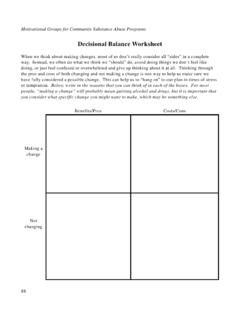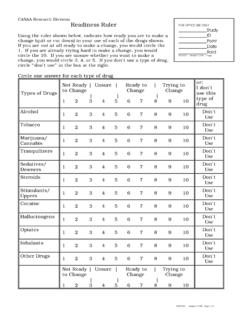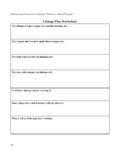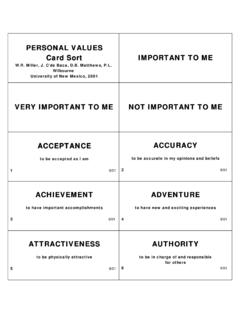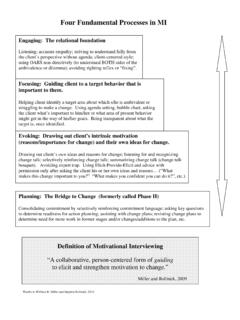Transcription of What is Motivation for Change? - Motivational …
1 what is Motivation for Change? William R. Miller, Paul Amrhein, and Carolina E. YahneClinical Research Branch, University of New Mexico Center on Alcoholism, Substance Abuse and Addictions (CASAA) Motivation for change is a much-discussed construct in addictiontreatment, for which there are many measures, definitions, andconceptions. As part of a larger clinical trial, multiple measures ofmotivation for change were obtained at intake for 234 adult clientsseeking treatment for substance use disorders.
2 Included were measuresof readiness, pros and cons of use, self-efficacy, change goals, anddecisional balance. A factor analysis (BMDP 4M) was performed usingprincipal factor analysis for initial factor extraction. To allow for thepossibility of inter-correlated variables, oblique rotation was used in thisanalysis (although orthogonal rotation yielded nearly identical results). Four factors emerged representing Readiness (high Taking Steps andhigh Problem Recognition on SOCRATES), Decisional Balance (SEDUand manipulandum), change Goals (WIWFT), and Self-Efficacy as afourth factor with no other measures loading on it.
3 These four factorsaccounted for of the variance among the measures across Motivation for change is often discussed as if it were a singleattribute, varying in intensity. Yet Motivation is measured in highlyvariable ways, sometimes considered to be interchangeable. Are thesevarious assessment methods simply different ways of tapping a singleunderlying dimension? To address this question, we administeredmultiple measures of Motivation simultaneously, to clients enteringtreatment for drug dependence.
4 Measures of Motivation1. Readiness for change . The Stages of change Readiness andTreatment Eagerness Scale (SOCRATES), with three factor subscales:(a) Problem Recognition, (b) Taking Steps, and (c) Ambivalence. 2. Pros and Cons. The Self-Evaluation of Drug Use (SEDU). Self-ratings of benefit vs. cost balance on 15 dimensions potentially affectedby drug Self-Efficacy. Self-assessment of ability to reduce or abstain fromdrug use (How I See My Drug Use).4. Goals. A survey ( what I Want from Treatment ) of goals that clientsmay wish to achieve in Decisional Balance.
5 A physical manipulandum allowing the clientto represent the overall positive versus negative effects of drugs in theclient s life. The client sets a balance bar, and then the angle ofdeflection is read from a protractor scale on the back of the part of a clinical trial of Motivational Interviewing in Drug AbuseServices (MIDAS), 234 adult clients were enrolled and completedbaseline measures of Motivation for change . Outcome data wereobtained via the Form 90 interview and urine drug tests at 3, 6, 9, and 12months after randomization.
6 Data for 22 of these clients were excludedbecause of untruthfulness in reporting their drug use outcomes ( , n=18where urine drug tests contradicted self-report of abstinence), or becauseof incomplete intake data (n=4), leaving a sample of 212 used for 212 participants were, on average 33 years of age, with 12 years ofeducation and median annual family income of $6,500. Womencomprised 47% of the sample, and in self-designated ethnicity 53% wereHispanic, 33% Anglo, 6% African-American, 2% Native American, and6% unspecified. The most common presenting drug problems were crack(31%), heroin (25%), and cocaine (23%).
7 Motivational FactorsFour factors emerged representing:I. Readiness (high Taking Steps and Problem Recognition ) II. Decisional Balance (SEDU and manipulandum) III. change Goals (WIWFT), and IV. Self-Efficacy as a fourth factor with no other measures loading on four factors accounted for of the variance among themeasures across the clients. The factor loadings were: I II III IVSOC Taking Steps .70 . Recognition ..18 .06 SEDU Total .03 ..16 change Goals ..50 ..01 .04 ..43 ..07 .21 .09% added among the Motivation measures were quite modest.
8 Theonly r value over .40 was between SOCRATES Taking Steps and ProblemRecognition subscales (r = .46). Correlations among the four factors werelikewise modest (highest r = between I and II).Predicting Drug Use OutcomesIf Motivational measures are valid, they might be expected to predictbehavior change . Here we used the four factors to predict percent daysabstinent (PDA) from illicit drugs across one year of follow-up. Thisrequired completed assessment interviews at 3, 6, 9, and 12 months,reducing the analyzed sample to N = 161.
9 Multiple regression analyses(MRA) revealed that Motivational measures did not predict baseline druguse. However, the model did reliably account for variance in treatmentoutcome PDA (R2 = .06 for Motivation measures alone, .17 when baselinedrug use was included as a predictor). In both cases, only Factor III(endorsing fewer change goals on what I Want From Treatment; = )and Factor IV (higher self-efficacy; = .19) uniquely predicted higherPDA. Factor I ( = .17; higher problem recognition) and II ( = ;decisional balance) were modestly related to higher PDA.
10 The decisional balance factor was comprised of two measures, which asit turns out loaded in opposite directions. On the SEDU, low scoresreflect judgments that, across various life dimensions, drug use is havinga generally negative effect ( = ). On the manipulandum, however,higher scores reflect an aggregate judgment that drug use is, on the whole,a bad thing for the client ( = ). Neither of these measures, however,accounted for unique variance above that predicted by baseline PDA. Does Motivational Interviewing Matter?In this study, clients were randomly assigned to receive or not receive amotivational interview (MI).
